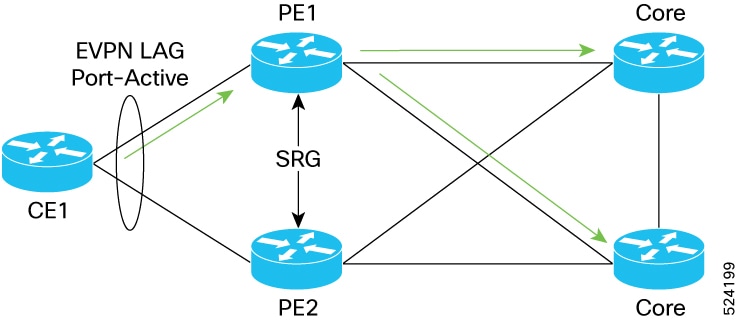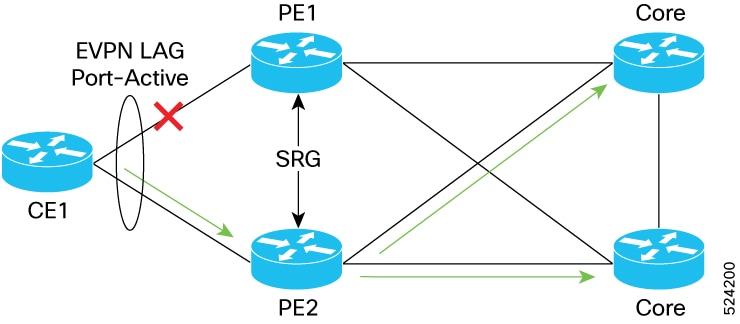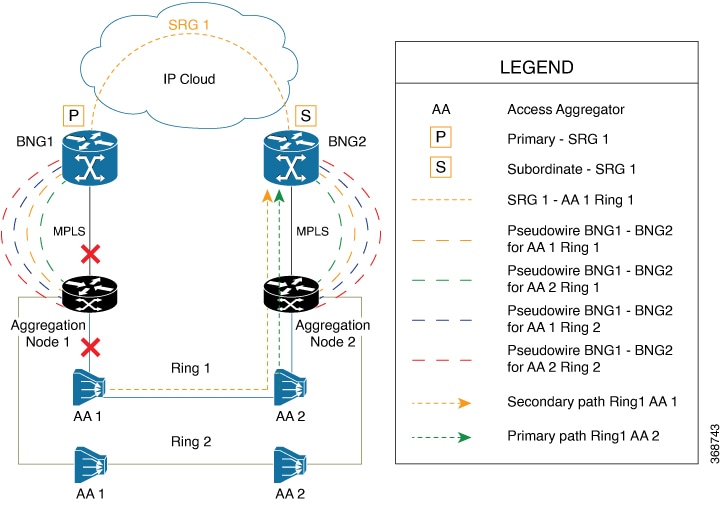Geo Redundancy Overview
To provide redundancy for the subscriber sessions, BNG supports Geographical Redundancy across multiple BNGs, without having any L1 or L 2 connectivity between them. The BNG routers may be located in multiple geographical locations, and they have L3 connectivity over a shared core network through IP or MPLS routing.
Geo redundancy feature is supported for IPoE DHCP-triggered (IPv4, IPv6 and dual-stack) sessions and PPPoE (PTA and LAC) sessions.
 Note |
PPPOE LAC geo redundancy is supported only with Multi-chassis Link Aggregation (MC-LAG) based access networks (active-standby mode) and RFC4951 compliant L2TP Network Server (LNS). |
This figure depicts a BNG geo redundancy deployment network model:

The redundancy pairing between BNG routers work by synchronizing the state from the primary (active) to the subordinate (backup).
Geo redundancy works in conjunction with any of the access technologies. The CPEs are agnostic to redundancy; they see only one BNG or gateway. The access nodes are dual or multi-homed for redundancy using a variety of technologies based on the service provider network design and choices. Multi-chassis Link Aggregation (MC-LAG), dual-homed (Multiple Spanning Tree - Access Gateway or MST-AG), Ring (MST-AG or G.8032), xSTP and seamless MPLS (pseudowires) are a few such access networks.
Subscriber Redundancy Group (SRG)
Geo redundancy for subscribers is delivered by transferring the relevant session state from primary BNG to subordinate BNG which can then help in failover (FO) or planned switchover (SO) of sessions from one BNG to another. Subscriber Redundancy Group (SRG) which is a set of access-interface (or a single access-interface) is introduced in BNG, and all subscribers in an SRG would FO or SO as a group.
-
Hot-standby
-
Warm-standby
Currently BNG geo redundancy supports only the hot-standby subordinate mode. This is achieved by a 1:1 mirroring of subscriber session state from the primary to the subordinate where the entire provisioning is done before the FO or SO. The sessions provisioned on subordinate is in sync with the set up on the primary. Because the data plane is already set up for sub-second traffic impact, there is minimal action on switchover in the case of hot-standby mode and therefore, it is suitable for subscribers requiring high service level agreement (SLA). With appropriate capacity planning, the sessions can also be distributed across multiple BNGs to achieve an M: N model. The primary-subordinate terminology is always in the context of a specific SRG; not for the BNG device as a whole.
 Note |
Even after the Subscriber Redundancy Group (SRG) configuration is removed from the subordinate node, the CPE continues to receive ARP replies from both the primary node and the subordinate node. This results in the network functioning in an uncertain manner. In order to avoid this uncertainty, shut down the access interface (that which corresponds to the subordinate node from which the configuration is removed) before removing the SRG configuration from the subordinate. |
This figure depicts a typical BNG subscriber redundancy group (SRG):

SRG Virtual MAC
For seamless switchover between two BNGs, the L2-connected CPE devices must not detect change in gateway MAC and IPv4 or IPv6 addresses. The access technology like MC-LAG uses the same MAC address on both BNGs with active-standby roles, providing seamless switchover. Where MAC sharing is not provided by the access technology or protocol ( like MST-AG, G.8032), the BNG SRG virtual MAC (vMAC) must be used. vMAC is configured as global MAC prefix or per SRG. This is integrated with BNG's dynamic primary or subordinate role negotiation; additional protocols like VRRP or HSRP is not needed. vMAC (and its derived IPv6 link-local address) is used for control protocol exchanges (for example, ARP, ND, DHCP, PPPOE and so on) and data traffic for subscriber sessions or services only. It allows real port MAC to be used for Ethernet protocols (like E-OAM, xSTP, G.8032 and so on) that are leveraged by the SRG for doing failure detection, recovery and MAC Flush.
Session Distribution Across SRG
The session distribution across SRGs can be in either of these modes:
- Active-standby mode:
In this mode, a dedicated backup BNG can be a subordinate for multiple SRGs from different active BNGs which are primaries for those respective SRGs.
This figure shows an active-standby mode of session distribution across SRGs: Figure 3. Active-standby Mode of Session Distribution 
In figure a: -
Sessions are associated with partitions (VLAN 1, 2, 3 and 4) on BNG1, with each VLAN mapped to separate SRG configured as primary role.
-
BNG2 acts as backup for all VLANs.
-
Each VLAN has 8K sessions terminated on it.
In figure b: -
An interface failure gets detected (using object-tracking of the access-interface) through MC-LAG.
-
MC-LAG and SRG for each VLAN on BNG2 gets the primary role.
-
All 32K sessions are switched to BNG2.
-
BNG2 sees a session termination count of 32K.
-
- Active-active mode:
In this mode, a BNG can be primary for one SRG and a subordinate for another SRG at the same time.
This figure shows an active-active mode of session distribution across SRGs: Figure 4. Active-active Mode of Session Distribution 
In figure a: -
Sessions are associated with partitions (VLAN 1, 2) on BNG1, with each VLAN mapped to separate SRG configured as primary role.
-
Sessions are associated with partitions (VLAN 3, 4) on BNG2, with each VLAN mapped to separate SRG configured as primary role.
-
Each VLAN has 8K sessions terminated on it.
-
Each BNG has 16K sessions terminated on it.
In figure b: -
The interface associated with VLAN 2 on BNG1 goes down.
-
Sessions associated with partitions (VLAN 2) on BNG1 are switched to BNG2.
-
BNG1 sees a session termination count of 8K and BNG2 sees a session termination count of 24K.
-
Benefits of BNG Geo Redundancy
Major benefits of BNG Geo Redundancy include:
-
Supports various redundancy models such as 1:1 (active-active) and M:N, including M:1.
-
Provides flexible redundancy pairing on access-link basis.
-
Works with multiple access networks such as MC-LAG, dual-home and OLT rings.
-
Supports various types of subscribers such as IPv4, IPv6 and dual-stack IPoE sessions.
-
Works for RP (bundle and virtual access-links) based subscribers.
-
Provides failure protection to access link failures, LC failures, RP failures and chassis failures.
-
Performs automatic switchovers during dynamic failures or planned events such as maintenance, upgrades and transitions.
-
Co-exists with other high availability (HA) or redundancy mechanisms.
-
Does switchover of the impacted session group only; other session groups remain on the same BNG.
-
Provides fast convergence and rapid setup of sessions, with minimal subscriber impact during switchover.
-
Provides automatic routing convergence towards core and efficient address pool management.
-
Provides seamless switchover for subscriber CPE without the need for any signaling.
-
Integrates with RADIUS or policy and charging rule function (PCRF) systems.
-
Provides minimal to zero incremental load on back end servers and PCRFs during normal operations and switchover.
-
Does not impact session scale and call-per-second (CPS) during normal operation.













 Feedback
Feedback